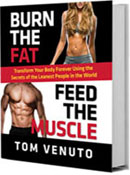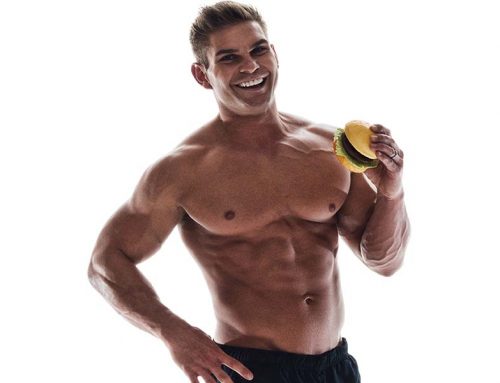It’s always the media and advertising-hyped stories of rapid and massive weight loss that get most of the attention these days (think “Biggest Loser”). It’s easy to look at these dramatic “success stories” and choose them as your role models. But it’s usually not the person who lost the most weight or who lost weight the fastest that you want to emulate. In fact, “losers” are the last people you want to listen to…
When you’re looking for people and methods to model, you should pay attention to maintainers not losers.

Maintainers are people who have lost weight and held a steady new ideal weight for at least one year. Long term maintainers are people who have kept the weight off for three to five years – and this is a remarkable achievement, given the statistics about relapse.
Any time you meet someone who has achieved their ideal weight and maintained it for five years or more, stop everything you’re doing, pay attention and learn from them. As you meet more of them, compare notes about what they have in common.
Unfortunately, finding long term maintainers is not easy. First of all, and sadly, there aren’t that many yet. Second, most commercial diet programs don’t keep track of their customers over the long term. The testimonials they publish are the most dramatic success stories which have been singled out as their poster children.
From a business point of view, you can’t fault them for that, but the results you see in the ads are rarely a true reflection of the usual amount of weight loss or the duration of weight loss maintenance. That’s why the FTC requires disclaimers such as “results not typical” on so many advertisements and before and after photos.
One group dedicated to tracking maintainers is the National Weight Control Registry (NWCR).
This joint collaboration of weight loss researchers was founded in 1994 by Dr. James Hill, a clinical nutrition researcher from the University of Colorado and Dr. Rena Wing, a psychologist from Brown University.
The NWCR began as a data base of men and women who had lost 30 pounds or more and maintained the loss for one year or more. Since its inception, the average participant has been even more successful than the entry criteria, having lost an average of 65 pounds and maintained the minimum weight loss for an average period of 5.5 years.
Information about this group has been collected through a series of surveys and interviews. Since this isn’t the controlled experimental type of research, it doesn’t prove cause and effect and is subject to flaws such as selection bias and the ever-present underreporting bias. Nevertheless, the NWCR is one of the most valuable sources of success strategies from weight maintainers currently available.
Many of the strategies here in my 10 keys to maintenance are based on the findings of this group and other groups like them.
The 10 Major Keys For Successful Lifelong Maintenance
The NWCR found many similarities among successful maintainers plus a few important differences. One difference was the type of program used. Half of the maintainers lost weight on their own, half of them used commercial programs.
Maintainers also used various types of nutrition programs with a variety of different macronutrient ratios and they customized their nutrition programs to suit their needs, lifestyles and dispositions.
This shows that it wasn’t a specific formal program that made the difference. It tells us that personal preference and metabolic individuality must be taken into consideration when choosing a program. No one can say that a single program is superior to all the others 100 percent of the time for 100 percent of people.
Despite the differences, the NWCR and similar survey studies reveal that maintainers have far more in common than they do different. It’s these commonalities in long term maintainers you’ll want to learn and emulate, and I have researched and listed them all for you below:
1. Maintainers have a plan for transitioning into maintenance phase
The worst thing you can do at the time you reach your weight goal is to abruptly end a diet and make sudden changes to totally different foods or a dramatically different quantity of food. The stricter your diet has been, the more important it is to include a gradual transition plan to take you from your caloric deficit level to your new maintenance level. If your calorie reduction and food restrictions were conservative, you won’t need much of a transition period; you should be able to safely bring your calories right up to maintenance without a problem.
A transition phase might take place over the course of a week or two, or it might stretch out as long as three to four weeks or more if your diet was very restrictive and know you are prone to sudden weight gain. Your objective is to slowly establish energy balance so your weight stabilizes. As you bring your calories back up to maintenance, use the weekly feedback method and continue to monitor your weight and body composition.
Remember that body weight is not the same as body fat, so don’t be alarmed if there is a small weight gain, provided your body fat percentage does not increase significantly. Sometimes you’ll gain two to three pounds as you raise calories back to maintenance (especially carb calories), but it’s usually lean tissue, water and muscle glycogen, especially if you had reduced your carbs during the fat loss phase. When your weight is stable and you’re neither gaining or losing week-to-week, you know you’re in energy balance and you’ve officially entered the maintenance phase, or if you prefer, the “lifestyle phase.”
2. Maintainers have very high levels of physical activity
Weight loss experts have argued lately about how important exercise is for weight loss (nutrition is clearly the most important factor). But one thing that almost every expert agrees on is that exercise and high levels of activity are vital for keeping the weight off. That’s not to say it’s impossible to keep weight off with no activity, only that it’s difficult. It would take very tight control over caloric intake and high levels of dietary restraint to maintain a large weight loss with no training or other physical activity during the maintenance phase.
The reason maintenance is difficult without exercise is that after a large loss of bodyweight, your calorie requirement (metabolism) is lower than before. It’s a bad idea to abruptly end your diet the minute you reach your weight goal and go back to the way you used to eat. It’s an even worse idea to abruptly stop exercising as well.
There have been many studies investigating the ideal amount of exercise for weight maintenance, and while the experts agree that exercise is important for maintenance, they can’t seem to agree on how much. You may have heard news stories claiming everything from “30 minutes of moderate physical activity most days of the week” to “an hour a day or more.” It’s hard to make heads or tails out of it all, especially since traditional exercise recommendations don’t always specify the intensity level or even the type of exercise.
My suggestion for lifelong maintenance is to simply continue following the same training guidelines that got you lean (such as found in the Burn the Fat, Feed the Muscle program). A good general guideline during maintenance is to perform three days per week of strength training, three days a week of formal moderate to intense cardio training and keep up an active lifestyle in general (lots of walking and recreational activity). If you were doing more than three days per week of cardio, you will probably be able to reduce back to a baseline level of three days per week, especially if that cardio is intense.
Adjust your training and activity level as needed based on your results just like you did during the fat loss phase. Why be bound by rigid rules or confusing research? Regular progress check ups for weight, body fat, measurements and visual appearance will tell you without a shred of doubt. Which leads us to number three…
3. Maintainers continue diligent self-monitoring
Research has proven over and over again that people who monitor their progress have a higher chance of succeeding at reaching their body fat goals. What clinches the deal is that self-monitoring of body weight and other measures of progress increases your chances for successful maintenance as well.
Among maintainers, the most five common self-monitoring methods include:
• tracking body weight
• tracking calories
• planning meals
• tracking dietary fat intake
• measuring the amount of food
I find it both ironic and scary that all five of these methods are among the behaviors that both weight loss “professionals” and dieters rally against! “(Throw away your scale, don’t count calories,” etc etc).
Among the NWCR maintainers who lost 65 pounds or more and kept if off for at least 5 years, 75% of them reported weighing themselves at least once a week. Many weighed themselves daily. Once you hit your target weight, don’t put that scale away just yet! Weighing yourself not only helps you take the weight off, it helps you keep it off.
4. Maintainers decrease sedentary activities
Long term maintainers are much more active than regainers, but they also make a conscious effort to cut back on sedentary recreational activities. It’s not just what activities you do that count, it’s what you don’t do. When you stop doing something sedentary, that will create a vacuum that begs to be filled, so to make the change stick, swap out the time you used to spend watching TV, surfing the web, playing video games or just lounging around for some kind of physical activity.
The best part of this strategy is that the new activity could still be recreational and fun, it simply has to burn some calories. Think about all the possibilities. This could be a great opportunity to take up some new sports or hobbies like surfing, boating, jet skiing, hiking, gardening, golf, carpentry, bowling, or tennis. These may not take the place of your formal cardio program, and definitely can’t take the place of weight training, but it will make a difference in helping you stay lean if you make it a part of your new lifestyle.
If you’re not a gym person, using this strategy can also help reduce the amount of time you need to spend on formal training. If you’re serious about maintenance, you’re going to need to stay active. But there’s no law that says you have to be indoors on a treadmill seven days a week, unless you want to.
5. Maintainers get serious about weight training
The types of exercise regimes used by maintainers may vary, but in the majority of studies, maintainers reported that they used weight training to help take the weight off and continued weight training through the maintenance phase. The majority of regainers didn’t do weight training during the weight loss phase and most didn’t pick it up in the maintenance phase.
Years ago, I did my own informal “research” on weight training and fat loss maintenance by looking at the habits and long term results of several hundred of my personal training and coaching program graduates. They all used weight training as a part of their fat loss programs. During maintenance, I noticed that the most successful of my clients were the ones who got extremely serious about their weight training to the point that it almost became like a hobby or recreational sport to them. A few even took up bodybuilding or figure competitions.
I believe the progressive and goal-oriented nature of weight training adds a motivational spark that keeps the fire of enthusiasm burning for years after you achieve your initial weight goal. Contrary to what many believe about exercise and aging, weight training is also a recreation or sport you can enjoy for the rest of your life. There’s no other type of exercise that will do so much for you as you get older to maintain your strength, functionality, mobility, and self-confidence.
Weight lifting isn’t just for bodybuilders! The benefits are incredible, and this type of training is still not getting its proper due in today’s discussions of fat loss and lifelong maintenance.
6. Maintainers respond quickly to counteract weight gain
One of the reasons that self-monitoring behaviors help so much is that they give you an early warning system to help put a lid on the weight creep. Putting a stop to creeping bodyweight also requires a certain mindset. The first part is a low level of tolerance for weight gain. Most successful maintainers have a rule for how much weight they’ll allow themselves to gain before they spring into corrective action.
Four pounds is a commonly cited figure. This makes perfect sense because most people say their normal weight fluctuation is about two to three pounds. As soon as they exceed that limit, they leap into action. When the early warning alarm goes off, they immediately go back into a caloric deficit by reducing food portions or increasing the number of calories burned through formal exercise.
The other side of killing the weight creep monster while it’s small is having high standards for the type of physique you want to maintain or develop. In my opinion, many trainers and nutrition professionals wimp out when it comes to helping people set their long term fitness goals. Their intentions are good, as they don’t want their clients to be unrealistic, but I think it would do a lot more good if they encouraged their clients to raise their standards.
The majority of maintainers believe that it’s not okay to be overweight and it’s dangerous to be obese. Other people, usually those who are struggling with their weight, argue that you have to accept yourself the way you are to be mentally happy and healthy. I don’t think anyone would disagree with that, except that this is “either-or” thinking. Fat and person are separate things so you don’t have to accept them together. Fat is not a person, it’s a temporary physical condition.
The person you are is much more than a mass of biological tissue. You can like and accept yourself as a person and at the same time proclaim that high body fat is unacceptable.
Unrealistic standards are certainly a possibility, so set yours based on what you really want, not what society says or implies is the ideal. Raising standards doesn’t mean getting skinnier and skinner. High standards include excellent body composition and all the other aspects of fitness including strength, muscularity, endurance, flexibility and aerobic capacity.
But almost all of us are so far away from our true physical potential and have so much room for improvement that it’s silly to downsize our goals and dreams because someone else thinks they’re unrealistic.
7. Maintainers follow the 7 lifestyle eating habits
The eating habits that help to keep the weight off are almost identical to the nutrition habits that take the fat off.
However, in virtually all of the long term studies about weight maintenance, 7 habits in particular show up at the top of the list over and over again.
Successful maintainers:
– Eat at least five fruits and vegetables per day. You can never hear this often enough: Eat more fruits and vegetables. They’re great for burning the fat off, great for keeping the fat off.
-Eat a high fiber diet. Successful maintainers report a high fiber intake from their high fruit and vegetable intake as well as from other natural starchy carb and whole grain sources such as beans, oats, legumes, brown rice, sweet potatoes, barley and so on.
-Eat breakfast every day. It’s no surprise that maintainers are breakfast eaters because strong correlations have been found between skipping breakfast and overeating or bingeing later in the day.
-Eat at fast food restaurants two or fewer times per week. A report on dietary practices and dining out behavior published by the Center for Disease Control found that adults who ate no more than two times per week at fast food restaurants were more successful at maintenance.
-Eat less dietary fat. Most maintainers report eating between 20% and 30% of their total calories from fat, significantly less than the national average of 35%. It’s important to consume enough of the healthy fats, but maintainers are aware that high fat foods are high calorie foods so quantities are controlled.
-Eat consciously. Long term maintainers are not mindless eaters. Even though healthy eating behaviors become habitual after years of repetition, successful maintainers are always vigilant and aware.
-Eat the same healthy foods all year round. Maintainers eat a wide variety of foods, but they are consistent all year round. There’s no dramatic difference between the foods eaten for maintenance because no weird or different foods are eaten for fat loss. To hold their weight steady, maintainers simply eat a little less of the same healthy foods during the fat loss phrase.
8. Maintainers continue using social support
I remember the first time I ever heard about lifetime memberships for weight loss programs. My first reaction was, “what a rip off! Why would you need a lifetime membership if the program actually worked?” After I started doing research and I discovered that ongoing social support was one of the secrets of successful maintenance, I realized that these programs weren’t just a money grab.
Of course, if you’ve been offered a purchase plan for fat burning pills with lifetime refills and monthly auto shipping, you might want to think twice about that one. I’m talking about professional coaching or support. If you choose to continue with coaching, counseling, or membership in some kind of fitness group, you can rest assured it will be one of the best investments you ever make.
Not only do maintainers seek support from professionals, they also use their natural social network to help them cope with personal problems. Regainers on the other hand, lack coping skills, they try to handle problems alone and they lapse back into using food as a coping mechanism.
Whether you work with a professional into the maintenance phase is your decision, but if you’ve ever relapsed in the past, give serious consideration to using formal support for a while after you reach your ideal weight. Most of the people who get past the one year mark have good prospects for maintaining their new weight for the long term, so having a coach or trainer for that period would be a great idea. Even if you don’t keep your trainer for years, yours can at least help you make the smoothest possible transition into maintenance.
[To learn more about our Burn the Fat support community, visit: www.BurnTheFatInnerCircle.com]
9. Maintainers become coaches and role models
Support is a circle, not a one way transaction. Someone gives support, someone receives it and then the receiving party either returns the favor to the same person or “pays it forward” to someone else. One of the best maintenance strategies is becoming a coach and support partner after you achieve your goals. Not only will you be returning the goodwill you received from others when you needed help, you’ll be keeping yourself motivated by taking a leadership position where others are looking up to you. To avoid disappointing them, you have to be congruent and practice what you preach
Being a coach or support friend for others could be as simple as posting your success story on a website or contributing to an online community. You might even become involved in the health and fitness business more formally. I believe that part of our purpose on this Earth is to serve other people. When you serve others, you get an incredible feeling you can’t get any other way. Emotional eaters use food as a way to make themselves feel better, but food wasn’t meant for that purpose. If you want a way to genuinely feel better, try service.
Give something back. Do it for selfish reasons if no other, because being a role model for others helps you achieve your own goals. Imagine what would happen if every person who achieved and maintained their ideal weight “paid it forward” by helping three other people reach and maintain their ideal weight. Maybe that’s just a cute idea from a movie. But maybe it’s much more.
10. Maintainers have vision
As you may have noticed, I do recommend setting short, mid and long term goals, including 12 week goals. I recommend planning by the 7-day week, and I suggest setting up your training in neatly organized 4 week blocks and 8 week cycles. I also think competitions are a great idea.
But fitness is not a 7 week or a 3 month program, it’s a lifestyle. Forgive me the cliché, but there’s no better approach to nutrition, training and health than thinking of fitness as a lifestyle. Programs and goals are just stepping stones, not the journey itself.
If the only plans you make are for winning a 12-week transformation contest or for looking good for a trip to the beach in 30 days, what’s going to keep you going after that? Even 5, 10 and 20 year goals have an ending point. What then? That’s where a vision comes into play. A vision is the big picture of what you want for your body and your health, but unlike a goal, a vision has no end point. You don’t arrive there or get it, you live it.
Putting a man on the moon before the end of the decade was a goal. The exploration and conquest of space is a vision. If there was no vision, would anyone be talking about going to Mars today? Here’s an example in the context of business:
Goal: To own a health club. Vision: To build a national fitness company that inspires thousands of people to achieve their health and fitness goals.
Now here are some examples in the area of fitness, sports and weight control:
Goal: To win the overall national bodybuilding championship title. Vision: To continuously improve and become the best natural bodybuilder I can be.
Goal: To complete a full triathlon. Vision: To continuously improve my performance and become the best athlete I can be.
Goal: To lose 100 pounds Vision: To easily maintain my ideal weight, improve my health, increase my quality of life and inspire other people with my success story
Each time you achieve a goal, you have to keep asking, what’s next? But if you have no vision, you’ll be at a loss for an answer. If you have a vision, the next step is an obvious and natural progression.
What’s your big picture? What’s your vision? Think about it hard and write it down. Then think about it some more and make it clearer and clearer. Vision, the never ending pursuit of new goals and personal improvement will be the driving forces that inspire, motivate and energize you for the rest of your life.
Train hard and expect success,
Tom Venuto, author of
Burn the Fat, Feed the Muscle,
The Bible of Fat Loss
Get Burn the Fat:
www.amazon.com/Burn-Fat-Feed-Muscle-Transform







I read the biggest loser article in the NY Times and noted that this gloomy article never said anything about weightlifting for muscle gain and metabolism which is directly related. Also these pathetic unrealistic hours of cardio are part of the problem IMO. It just didn’t sit well with me and the article made me want to pound weights and eat plenty of clean calories to keep my metabolism fast.
Hi, I just want to say a very big thank you to you…. A few years ago I was 20+ kilos overweight and I came accross your website and avidly read you ebook on the subject. I never entered any of your competitions but have maintained contact with your blog. As a result I reached my goal and have managed to stay there for a number of years now.
I totally agree with your steps to maintain, cos they have worked for me.
I don’t attend a gym but have some exercise equipment at home, and it has so become a lifestyle that when my elyptical trainer became faulty and had to be repaired a short while ago I really really missed it. I did continue with my weights and floor exercises but was hugely happy to get my machine back.
It unfortunately is still a little faulty, but it has galvanized me to start saving now for a new one, so that when it eventually gives up I will be in a better place to replace it.
So once again real thanks for your web site your book and the constant encouragement to keep going from your blog. It has absolutely revolutionized my life and I will be forever grateful for your totally practical and balanced eating and exercise program.
Hello, the article is very good, as everything that Tom Venuto does. I have lost 37,5 ponds many years ago, so I can agree with these 10 facts. While I was losing weight, beside other sources I found here many good advices that helped me. I can agree that I have changed my lifestyle, my point of you, it is not short program or died, you have to embrace new habits that become a part of you. I taught it is not posible, I ate 300g of chocolate every day! And now I can say I didn´t eat it for 7 years, and even cannot eat anything sweet because it is now disgusting for me, my tastes has changed. It is all about making first step, and day after day it will become habit, and mindset will change, and you will be better and better at what you do, you will see that you can do it, and you can do it better then you ever imagined. You will then set new goals, get new ideas, and get a desire to help others with same problems. It is all about first step and when you feel difficulty just make an effort to endure a little bit more, and every day a bit more, because we are not conscious how much we can achieve unless we try. I am available if someone´s need any help or advice.
Great info. Checking out your Amazon (nice reviews as well) now :)
Tom, did you ever run into Dragan Radovic? I do his dumbbell challenge about once a week. Tom, you have lots of good ideas in your blog. On your point #2, here’s something everyone can do throughout the day to increase their physical activity. Way back in 1962 I read an article by Reg Parks in a muscle magazine. Reg had won a Mr. America contest and revealed his secret technique for slimming his waist and abs. He would pull his stomach in and up for 5 seconds. He would do this 5 times for one set. You can do this technique anytime and anywhere; while you’re sitting in your car waiting for the light to change, waiting for your coffee to perk, waiting for the microwave, in the checkout line at the grocery store, waiting for an elevator, waiting for your computer to start and while you’re filling your gas tank. Pick three times a day that you can begin doing this simple movement. Start in the morning while you’re brushing your teeth. I have some other ideas that work at ezwayfatloss.com. Tom, thanks for your website and I agree that weight training is critical for both losing and maintaining. Stan Mysliwiec
Being fit must not stop. Your sacrifices has been paid off by achieving the body that you wanted. You must continue what you’re doing, that’s why lots of patience is really the key to it. You should be a role model to everyone, you just don’t know how other people want to be like you. Being fit should be forever.
Tom,
Thank you for posting such interesting research.
I can confirm the lesson you are trying to impart in #2. I post this for the benefit of anyone planning to return to a highly sedentary life after achieving their weight-loss goals.
Last year, I dropped from 210 lbs to 160 lbs (aided by your book’s calorie guidelines). I was happy with this progress. But I had much more work to do because my 6 pack was still “not in sight”.
Unfortunately, I had to abruptly stop. At the beginning of this year, I suffered an illness which left me limited in mobility. My lifestyle was basically sedentary for the first 6 months of this year. Along with this, I returned to what most would consider “normal” eating patterns (3 reasonable – but not calorie counted – meals a day).
By the time I recovered to 100%, I had shot up to 187 lbs. Science might say this was a gain of pure fat, due to my lack of exercise in this time period. The mirror was proof, as my face looked a little more plump…my stomach & waist as well.
By the way, I am 100% vegetarian. I eat mostly “clean”. Tom has tried to explain before, this alone will not save you people. Now you can take it from me as well.
I am now back at 100%. After a month back to running & weight lifting, I have dropped to 180 lbs. I will keep going until I reclaim old glory (and push further to uncover those lost ruins called my abs) ;)
So again…in case you had this fantasy that you could lose all that weight…and then just revert back to laying about eating & playing video games all day…my experience should give you pause. You can gain it back very quickly.
Best!
Paul
Mr. Venuto,
At 72 years old, I read part of your beliefs about weight loss. It took me a long time and diabetes and other health problems to realize first on my own and then by reading your comments that where exactly the conclusion I came to. You did teach me some new ideas especially about calorie intake and weight loss. That is exactly what I have been doing even though some people did not agree. The one thing that especially stood out to me was the every 6 or 7 days or so I splurged feeling that by paying attention to my body I needed that jolt.People more or less thot the very opposite. Stick to it stick to it stick to it. You are the only one that proved I am on the right path. It has taken me a long time but that is okay with me. I have lost and average 1 to 2 pounds a week for the last year. From 310 pounds to 262 has been slow and steady. I am happy with that. Thank you so much for your inspiring messages. Nyoka Patton